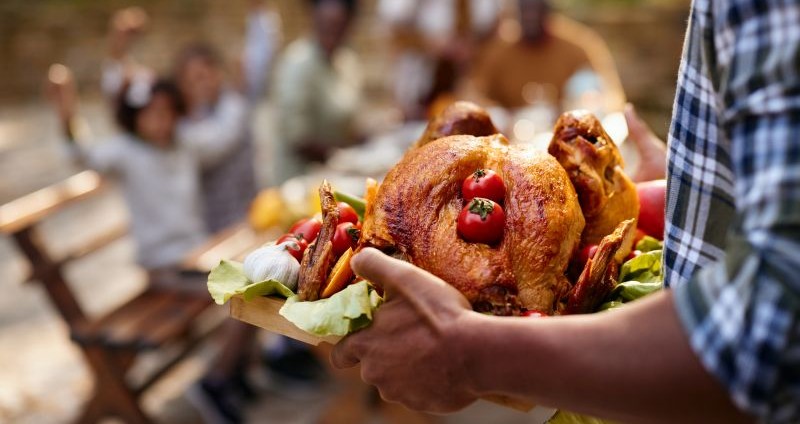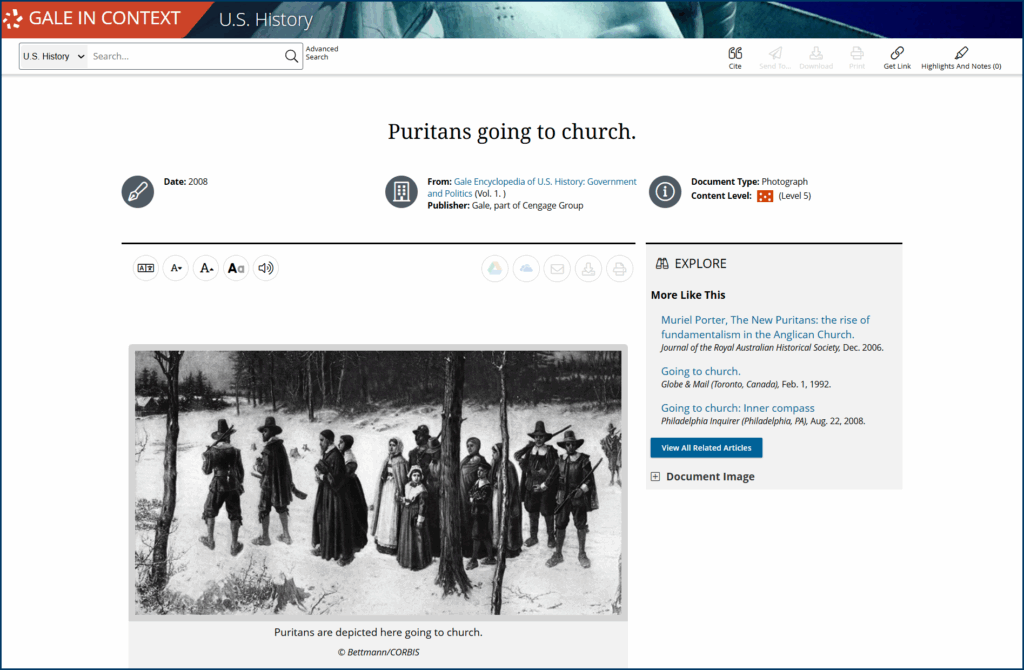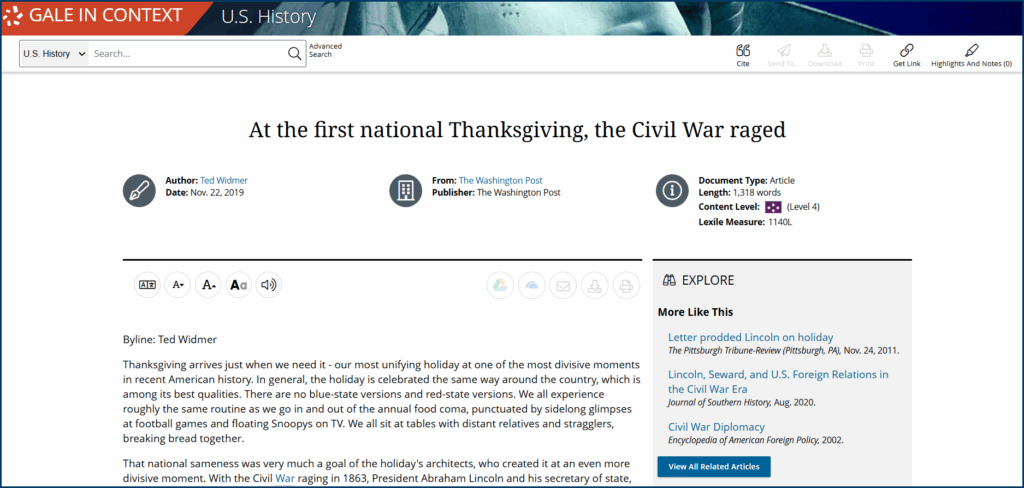|By Gale Staff |
As fall transitions into the holiday season, students begin dreaming of winter break and spending time with loved ones. You can take this opportunity to spark discussions about Thanksgiving to connect students’ impatience for the holidays with lessons about how the traditions we take for granted came to be.
To get started, explore the rich collection of articles, biographies, videos, audio files, and images—along with helpful tools to explore them—available at Gale In Context: U.S. History. These resources can help learners appreciate the complex and nuanced history of Thanksgiving, including its origins in colonial America. Students will also develop an enriched understanding of how the holiday has evolved, and the different ways that Thanksgiving has been celebrated over the years.
Trace the Story of the First Thanksgiving
Most children are familiar with the story of the Pilgrims, who landed at Plymouth Rock in 1620. A year after their arrival, these early English immigrants held a feast to give thanks to God for their survival through the trials they had encountered in their crossing and their first year in what would become the Massachusetts Bay Colony. In gratitude and recognition of the role the Wampanoag had played in teaching them how to raise crops, the Pilgrims invited them to join their celebration.
While there are elements of truth to this narrative, certain perspectives have been exaggerated and others neglected in the transition from historical account to legend.
Understand the Puritan Roots of the Pilgrims
The Pilgrims, as they are commonly known today, were Puritans—a religious group that believed the Church of England had not sufficiently “purified” itself from the influence of the Catholic Church, from which it had split under the reign of Henry VIII.
In the 17th century, a small sect of Puritans, the Separatists, thought the Church of England was beyond reform and fled England. They first emigrated to the Netherlands and then to North America to found a society according to their protestant Christian ideals. These are the Pilgrims who landed in Massachusetts and founded Plymouth Colony.
Reexamine the Portrayal of the Wampanoag People
Perhaps one of the most overlooked elements of the first Thanksgiving story is the influence of the Wampanoag and other Native tribes living in present-day Massachusetts. The Wampanoag and other Indigenous nations in North America have held harvest feasts and ceremonies for thousands of years. The Wampanoag, in particular, participated in seasonal thanksgiving celebrations long before encountering the Puritan settlers.
The Wampanoag and other local Indigenous tribes had been interacting with Europeans for almost 100 years before the arrival of the Puritans in 1620. However, the relationship between the Wampanoag and the Puritans has been oversimplified. On one hand, the Wampanoag remained cautious about the Puritans, who, driven by hunger, had desecrated their graves, where bodies were buried with stores of seeds, beans, and corn. Also, the Puritans were generally fearful of their Native neighbors and went to great lengths to hide that their numbers were shrinking due to sickness and starvation.
It took time, observation, and careful negotiations for relations between the Wampanoag people and Puritans to soften. After several diplomatic exchanges, the Wampanoag agreed to teach the settlers about cultivating crops and other methods of survival. Cooperation and peace-making were just as much about building alliances for trade and security as they were about fostering friendship and mutual understanding.
Critical Thinking Questions
- What did the Wampanoag have to gain (or lose) from offering to cooperate with and support these early settlers?
- Why are certain elements of history remembered differently from how they actually occurred?
Thanksgiving Celebrations Before 1621
Was the first Thanksgiving really in 1621? Or potentially much earlier? While it is true that the settlers at Plymouth shared a feast of thanksgiving in 1621, there were other earlier celebrations, including:
- St. Augustine, Florida, 1565: One of the earliest European settlements in the present-day United States, St. Augustine was the site of a feast of thanksgiving between Spanish colonizers and the Indigenous Timucua. Leftover food from the transatlantic voyage comprised the meal.
- San Elizario, Texas, 1598: A day of gratitude on April 30 commemorated the successful crossing of the Chihuahuan Desert from Mexico to the Rio Grande, led by Spanish explorer Don Juan de Oñate. The celebration included a feast shared with the local Mansos tribe, the first theatrical performance on record in America, and a reading by Oñate declaring the territory for Spain.
- Berkeley Plantation, Virginia, 1619: The Berkeley Hundred colony had a religious service in December to mark the safe arrival of their ship, and proclaimed December 4 as a “day of thanksgiving to the Almighty God.”
Curious to learn more about the origins of Thanksgiving? Read about the historical figures who played critical roles in shaping this holiday.
Thanksgiving Through the Years
Throughout the colonial period, the autumn Thanksgiving feast continued to gain popularity and spread across New England. Many colonies began declaring annual days of Thanksgiving, with Connecticut becoming the first to do so in 1639.
During the early 18th century, Thanksgiving began to resemble the holiday most Americans celebrate today. These early celebrations included family gatherings, large feasts, and displays of gratitude. At the time, Thanksgiving was widely considered a religious holiday and involved morning and evening church services.
In response to a 1789 congressional resolution, George Washington issued a proclamation declaring a national day of Thanksgiving. However, not all subsequent U.S. presidents upheld Washington’s proclamation. Referencing the First Amendment, Thomas Jefferson claimed the federal government had no place in promoting public prayer or compelling religious activities. Because of the religious overtones of the holiday, he argued that declaring it an annual holiday should be left to the states. Interestingly, by 1850, almost every state and territory observed an annual Thanksgiving holiday.
Thanksgiving underwent significant changes during the Civil War. In the fall of 1863, Lincoln established a nationwide day of Thanksgiving, set for the last Thursday of November, which the U.S. observes today.
In 1939, November had five Thursdays, and there was debate over whether Thanksgiving should be on the fourth Thursday (November 23) or the fifth (November 30). In 1941, at the urging of President Franklin Roosevelt, Congress set the fourth Thursday in November as Thanksgiving Day.
Critical Thinking Questions
- What values about our new nation was President Washington attempting to promote by establishing Thanksgiving as a national holiday?
- How did the Civil War influence President Lincoln’s formalization of Thanksgiving as a national day of observance?
Highlight Contemporary Thanksgiving Traditions in the U.S.
The popularity of Thanksgiving has only increased through the years, but not everyone celebrates it the same way—and some people don’t celebrate at all. Let’s take a look at some contemporary traditions behind this annual celebration.
Discuss the Significance of the Thanksgiving Dinner
When thinking about the Thanksgiving dinner, most people naturally think of the turkey. Did you know that, of all the whole turkeys sold in the United States each year, Americans eat about 50 percent of them on Thanksgiving Day? That’s about 40 million birds!
Besides roasted turkey, a Thanksgiving feast can also include traditional foods such as cranberry sauce, mashed potatoes with gravy, green bean casserole, sweet potatoes, and pumpkin pie. Regional variations include cornbread dressing on many Southern tables and oyster stuffing in New England.
The Presidential Turkey Pardon
The pardoning of the Thanksgiving turkey at the White House is a long-standing tradition that dates back to the 1970s. Presidents have received turkeys as gifts since the 1870s, when poultry businessman Horace Vose sent a fattened turkey to the White House for the Thanksgiving table. However, not all First Families ate the birds they received over the years.
While John F. Kennedy spared a turkey in 1963, President Ronald Reagan was the first to confer an official pardon. Many commanders-in-chief since then have added their own lightheartedness to the annual event. For example, President George W. Bush said, “I now have the duty of ending the suspense of our feathery guest,” when he invoked his pardon power in 2001.
Thanksgiving Day Football
The connection between football and Thanksgiving is not a new one. During the 1880s, Yale and Princeton engaged in an annual football rivalry on Thanksgiving Day. By the 1890s, thousands of high school and post-secondary football games were part of the tradition, with many colleges and universities holding their games the day after Thanksgiving.
Indigenous Attitudes Toward Thanksgiving
November is Native American Heritage Month, culminating with Native American Heritage Day the day after Thanksgiving. These observances provide an opportunity to better understand the rich cultures and traditions that predate the arrival of the Pilgrims and other European settlers by thousands of years.
Today, Indigenous attitudes toward Thanksgiving in the United States are diverse. Some participate in the traditional aspects of the holiday, despite the complex history behind the celebration. Others see Thanksgiving as a reminder of historic wrongs committed against Native peoples.
In 1970, the United American Indians of New England designated the fourth Thursday in November as the National Day of Mourning. Every year, they organize a protest rally on the fourth Thursday of November to raise awareness of the history of Native peoples in the Americas, celebrating the vibrancy, persistence, and innovation of Native American culture today.
Critical Thinking Questions
- How have traditional and social media transformed how we view and celebrate Thanksgiving?
- Consider popular cultural portrayals of Thanksgiving narratives. Whose stories tend to be included? Who got left out?
- What Indigenous viewpoints or perspectives have been romanticized (or neglected) in our mainstream understanding of the Thanksgiving holiday?
Engage Your Students with Real-Life Accounts and Learning Activities
Have students read firsthand accounts of people who have documented their perspectives surrounding Thanksgiving. For example, consider Henry Cumings’s 1775 “A Thanksgiving Sermon,” which interwove religious and political commentary to argue that the colonies were on the right side of the American Revolution. Have students reflect in writing on the following issues:
- How does Cumings’s tone regarding Thanksgiving compare with messages from more recent years?
- What civil and moral duties does Cumings promote? Are they still relevant today?
- Given that Cumings delivered his sermon in the early months of the American Revolution, how might the war have influenced what he said?
With inspiration from historical firsthand accounts of Thanksgiving in years gone by, students in literature, history, or creative writing classes can adapt and reimagine them in their own essays, poetry, or short stories. Prompts can include:
- Rewrite Cumings’s 1775 sermon (or another historical Thanksgiving commentary) for a contemporary audience, honing in on modern-day themes and current events.
- Compose a short story about a family Thanksgiving dinner in another historical era (or even in the future!). Explore how their celebration might have been different from ours today—and how key elements remain the same. What sort of food are they eating? What are they talking about around the dinner table? What current events are on their minds?
Visit the Gale Support portal for additional ideas on activities to keep your students engaged.
Partner with Gale to Enhance Student Learning
Discussing the historical, cultural, and social implications of Thanksgiving can help students connect with their own sense of tradition. Gale provides many resources, including Gale In Context: U.S. History, to help you empower learners and encourage them to engage more thoughtfully and critically with course material.
If you have questions or would like more information about Gale, please contact your local representative today.



